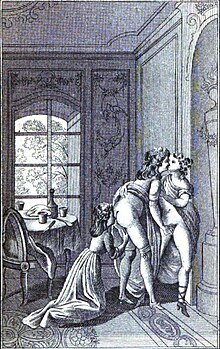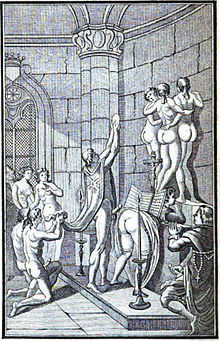Justine or the misfortunes of virtue
Justine or the Misfortunes of Virtue (French: Justine ou les Malheurs de la vertu ) is a novel by Donatien Alphonse François de Sade, better known in the history of literature as the Marquis de Sade. The first version of the novel was written in 1787. In 1791 and 1797 two different versions of the novel were published. It is one of the most important and influential works of its author, along with The 120 days of Sodom and Philosophy in the boudoir.
Post
Their original titles were successively Les infortunes de la vertu, Justine ou les Malheurs de la vertu, La nouvelle Justine ou les Malheurs de la vertu . The work was written by the Marquis de Sade during one of his long stays in prison, in the Bastille. The first version, simply titled The misfortunes of virtue, was written in just fifteen days, and its author declared it finished on July 8, 1787, remaining unpublished until Apollinaire rescued his manuscript from & #34;Hell" from the National Library of France at the beginning of the XX century. This initial version is significantly inferior in length to the final ones, although the plot, situations and development are already present in it. After his release from prison in 1790 (thanks to a decree of the National Constituent Assembly), Sade printed a second, more explicit version in June 1791, in which the narrated adventures were considerably expanded.
In 1797 a third version of the work was published, also attributed to Sade, with the title The New Justina or the misfortunes of virtue, followed by the Story of Juliet, her sister, also expanded from the previous edition. Justine's publication caused a huge scandal and aroused the most virulent criticism. Sade was described as an "infamous author of detestable novels." Despite the fact that it was published clandestinely and Sade always denied its authorship, Justine was the main cause for him to be locked up for life in different health institutions accused of "libertine dementia".
Already during his lifetime, Sade's work was widely distributed, six editions were printed in ten years, and Justine became a cursed work that circulated clandestinely throughout the century XIX. His influence is recognized in the novels of Flaubert, Dostoevsky and in the poetry of Baudelaire; although the list of writers of the XIX century in whom the influence of Sade has been sought, and more specifically of his novel Justine, it's extensive. At the beginning of the XX century, Apollinaire published L'œuvre du Marquis de Sade and the Surrealists they rescue the memory of Sade; since then, numerous authors have been interested in his work; but it will have to wait until the middle of the XX century for its publication to be normalized.
Plot
Justine is a teenager who is left an orphan after her parents died, she resorts to all social classes to get a decent job and preserve her virtue and in all cases, instead of receiving help, what she finds is incitement to vice. Justine symbolizes the virtue that she, with little intelligence, must face the tricks of vice and, contrary to what she might expect, instead of being rewarded for maintaining her virtue, what she receives is all kinds of grievances.
On the contrary, the libertines who abuse her are rewarded. Anti-heroes, so to speak, often emphasize their philosophical beliefs, rooted in atheism and sadism. Sade pours his misanthropy into this work, describing how in the society in which he had to live, practicing virtue is always onerous, while those who practice vice find a complicit and corrupt society, which allows them to gain an advantage.
"Which fatal star I must have been born, I said, so that it is impossible for me to conceive a single feeling of virtue that is not immediately followed by a flood of evils, and how is it possible that this illustrious providence, whose justice I rejoice in worshiping, by chasing me for my virtues, has offered me at the same time the vision of those who were me with their vices in the cuspide?"
Analysis
As in most of Sade's works, two levels of content can be observed. On the one hand, a series of scenes of sexual violence; on the other, the justifications for the crimes and perversities that those characters carry out. Certain authors have wanted to see in the arguments of these characters the thought of Sade himself, a philosophical and political system of a materialist nature, although this was not the predominant trend in the French Enlightenment. He was slightly opposed to the ideas of Jean-Jacques Rousseau whom he, however, admired. However, this work cannot be considered atheistic as his persecutors claimed. This is seen in both the prologue and the conclusion:
STAMPA EXPLICATIONWho knows, when Heaven strikes us with its blows, if the greatest misfortune is not good for us!
The Virtue, between Lujuria and Irreligion. On his left is the Lujuria, under the figure of a young man whose leg surrounds a serpent, symbol of the author of our evils; he draws with one hand the veil of the Pudor, which protected the Virtue from the looks of the profane, and with the other, as well as with his right foot, directs the fall in which he wants to make it succumb. On the right is the Irreligion that holds one of the arms of the Virtue with strength, while with a perfidious hand pulls a snake out of its breast to poison it. The abyss of Crime is interwoven under its steps. The Virtue, who always owns his conscience, raises the gaze of the Eternal, and seems to say:
May you be convinced with her that authentic happiness is only within virtue, and that if, with intentions that are not for us to deepen, God allows it to be persecuted on Earth, it is to compensate her in heaven with the most halac rewards!
In his time Sade suffered criticism for the "philosophical systems" which exposed the libertine characters of him. In response to these criticisms he writes:
"Every actor of a dramatic work must speak the language established by the character he represents; that then is the character who speaks and not the author, and that is the most normal thing in the world, in that case; that this character, absolutely inspired by his role, says things completely contrary to what the author says when he is the same who speaks. Certainly, what a man would have been Crébillon if he had always spoken like Atrée!; what a man would have been Racine if he had thought like Nero! What a monster would have been Richardson if he had not had other principles than those of Lovelace!"To Villeterqué folicululario
It is in this work by Sade where the influence of Voltaire and his philosophical tales can be most clearly appreciated (specifically it reminds us of Candide). As often happens in the works of the marquis, the narrated adventures seem to be an excuse to make it possible to expose different philosophical systems.
In Justine, Sade uses the protagonist to symbolize virtue and express his pessimistic thesis according to which virtue is systematically crushed by vice; while vice, free of values and principles, takes advantage and prospers. Starting from this thesis, Sade, in the introduction, worries about those who, lacking a solid moral formation, may come to the conclusion that it is better, more advantageous, to practice vice and not virtue.
"Will they not say that virtue, however beautiful, becomes the worst party that can be taken, if it is too weak to fight against void, and that, in a totally corrupted century, it is safer to act like others? Something more instructed, if you want, and abusing the lights you have acquired, will you not say with the angel Jesrad of Zadig, that there is no evil that will not come for good, and that you can, from there, surrender to evil, since in fact it is only one of the ways to produce good? Will they not add that it is indifferent to the general plan that such or whatever is preferably good or bad; that if the misfortune persecutes virtue and prosperity accompanies crime, being both equal for the projects of nature, it is infinitely better to take sides among the wicked, who prosper, than among the virtuous, who fail? It is therefore important to prevent these dangerous sophisms from a false philosophy. »
Sade uses the formula of the omniscient narrator in his work, who comments on the development of the plot, draws conclusions and exhorts the reader using the second person plural. Justina is about the miserable life of Justine, a young girl endowed by nature with an irresistible drive toward virtue, but left as an orphan, she is faced with a world full of libertines. She and her sister Juliette are forced to make a living as they can, but while Juliette, naturally inclined to vice, decides to prostitute herself, which leads her to achieve success and respectability, good Justine is determined, against all odds. tide, in wanting to lead a virtuous life.
Almost twenty years after their separation, the two sisters meet, without recognizing each other. Juliette is the wife of an important personage, and Justine is completely helpless. The second relates to her first her misadventures in the first person: how, because of her inclination to her virtue, she was again and again harassed, without ever finding peace. Justine's account occupies most of the book. At the end, Justine is recognized by Juliette, who decides to help her, but shortly after, Justine is struck by lightning, unable to enjoy the quiet life that her sister is determined to provide her.
Sade grants the reader a conventional ending. Justine's death must not be sterile. In the introduction she advances the plan of the work:
"It is essential to demonstrate that the examples of unfortunate virtue presented to a corrupted soul, in which nevertheless remain a few good principles, can return this soul to good with as much security as if it had been shown on the path of virtue the most brilliant successes and the most halactic rewards. »
In accordance with this plan, Juliette, moved by her sister's misfortunes, understands the greatness of virtue and, regenerating herself, vows to lead a pious life. The narrator concludes in the last paragraph of the novel that, Somehow, Justine's virtue must find its reward in the afterlife.
The plot itself and the ideas expressed in the novel are extremely radical for its time, with strong criticism of social organization and religion. The virulence of his criticism of the established regime and the possible references to influential figures of the time, earned Sade a lifelong imprisonment in the Charenton asylum.
In 1967, the cinematographic staging of the film was shot in Italy, Justine ovvero le disaveventure della virtú, which in Spain initially had the curious title of Deadly Passion. It was directed by Jesús Franco, with Klaus Kinski and Romina Power as main figures. Subsequently, there have been other film conversions of the work, such as Justine de Sade, a French film produced in 1972, directed by Claude Pierson and with Alice Arno in the role of Justine.



